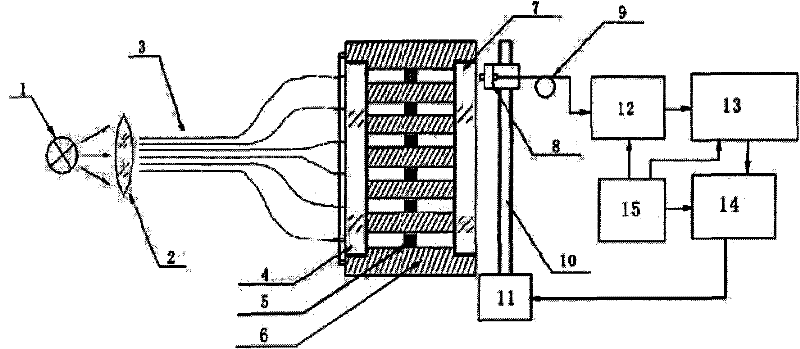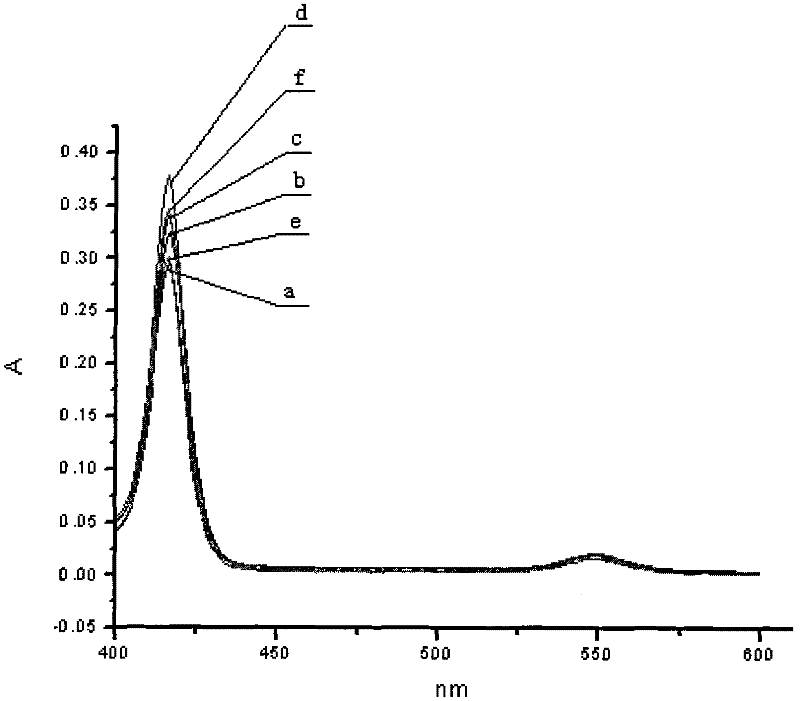Method for detecting organophosphorus pesticide residual quantity and liquid porphyrin optical detection apparatus
A technology for organophosphorus pesticides and residues, which is applied in the measurement of color/spectral characteristics, etc., can solve the problems of increasing processes and man-hours, complicated operation processes, and increased production costs, and achieves convenient and rapid detection, good repeatability, and improved work efficiency. Effect
- Summary
- Abstract
- Description
- Claims
- Application Information
AI Technical Summary
Problems solved by technology
Method used
Image
Examples
Embodiment 1
[0065] In step 1.1), pentafluorotetraphenyl zinc porphyrin is used as the photosensitizer, acetonitrile organic solvent is used as the fixed solvent, and the volume ratio of pentafluorotetraphenyl zinc porphyrin: acetonitrile organic solvent is 1: 10 6 Add the pentafluorotetraphenyl zinc porphyrin to acetonitrile, stir to dissolve, and prepare the pentafluorotetraphenyl zinc porphyrin with a concentration of 10 -6 The mol / L pentafluorotetraphenyl zinc porphyrin solution should be placed in the refrigerator and stored at 3°C in the dark for later use.
[0066] 1.2) In step, the volume ratio of the known organophosphorus pesticide solution: the volume ratio of the fixed solvent is 1:10 4 The organophosphorus pesticide solutions are prepared separately; the organophosphorus pesticides are dimethoate (40% EC), dimethoate (40% EC), dichlorvos (80% EC), chlorpyrifos (40% EC), hydrocarbophos ( 40% EC), phorate (40% EC), etc.
[0067] In step 1.3), the volume of pentafluorotetraphenyl zi...
Embodiment 2
[0071] In step 1.1), zinc porphyrin is used as the photosensitizer, acetone organic solvent is used as the fixed solvent, and the volume ratio of zinc porphyrin substance: acetone organic solvent is 1:10 5 The zinc porphyrin was added to the acetone organic solvent, and after stirring and dissolving, the mass concentration was 10 -5 The mol / L zinc porphyrin solution is placed in a refrigerator and stored at 4°C and protected from light for later use.
[0072] In step 1.2), five known organophosphorus pesticide solutions (i.e. dimethoate (40% EC), dimethoate (40% EC), dichlorvos (80% EC), chlorpyrifos (40% EC), hydrocarbophos (40% EC) volume: The volume ratio of acetone is 1:10 5 The proportion of five kinds of known organophosphorus pesticide solutions were prepared.
[0073] In step 1.3), the volume of zinc porphyrin solution: the volume ratio of five known organophosphorus pesticide solutions prepared in step 1.2) is (1~10 6 ):1, configure sample porphyrin detection solutions with...
PUM
 Login to View More
Login to View More Abstract
Description
Claims
Application Information
 Login to View More
Login to View More - R&D
- Intellectual Property
- Life Sciences
- Materials
- Tech Scout
- Unparalleled Data Quality
- Higher Quality Content
- 60% Fewer Hallucinations
Browse by: Latest US Patents, China's latest patents, Technical Efficacy Thesaurus, Application Domain, Technology Topic, Popular Technical Reports.
© 2025 PatSnap. All rights reserved.Legal|Privacy policy|Modern Slavery Act Transparency Statement|Sitemap|About US| Contact US: help@patsnap.com



